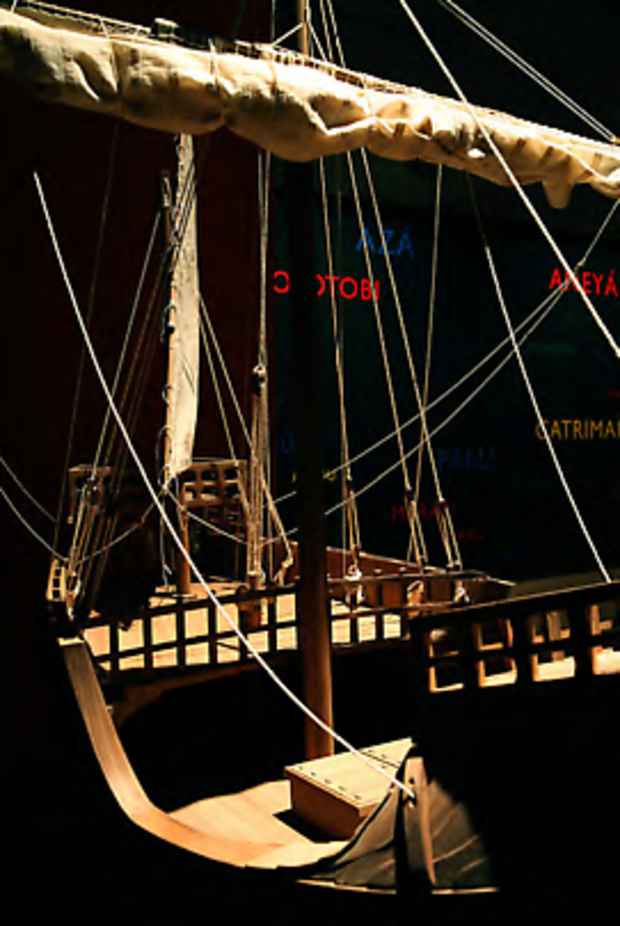Lothar Baumgarten “Los Aristócratas de la Selva y la Reina de Castilla”
Marian Goodman Gallery

This event has ended.
Baumgarten has developed a diverse yet consistent body of work over the last four decades, which is centered on ethnography and anthropology.
’Los Aristócratas de la Selva y la Reina de Castilla’ is a work in progress, of several different components, within the existing architectural conditions of the exhibition space. At the center of the presentation are four ship models at a scale of 1:20. One coca, two caravels, the ‘Pinta‘ and the ’Niña’, beside the vessel ’Santa María’.
The ship models signify through their magnificent manufacturing, the highly sophisticated nautical technology and engineering at the time of the Discovery of the Américas. The ‘Santa María’, originally built from wood of the Cantabrian forests, emphasizes the great maritime culture of this rough coast in northern Spain. The boats rest on metal cantilevers, representing the waves of the ‘Ocean Sea’ they would sail.
The gallery’s columns and the bases for the ships are hand-stained with Onoto seeds (Bixa orellana L.), a plant source used for body paint by most South and Central American native peoples - common practice that mistakenly led, early on, to the name ’Red Skin’. This vibrant natural pigment and its aroma refer in this context to the animistic beliefs of Amerindian societies. The white ceiling beams of the architectural space stand out and mirror the frame structure of the ships. The center of the exhibition transforms itself into the inner sections of a ship. It also represents the central plaza of a native house: shapono, maloka, or churuata etc., as a sheltered world, mirroring the surrounding tropical cosmos and its equatorial firmament, mutating into a zone and a space of contemplation.
Through it’s multi-layered discourse, the surrounding score of native river names represents the widely varying and rapidly vanishing languages of the non-writing societies - among them, the Pemón (Arekuna, Taurepan, Kamarakoto, Ingariko), Yé kuana, Hoti, Panare, Piaroa, Warao, Arawak, Sanema, Yãnomãmɨ, Baré, Makú, Wapishana, Makushi, Wai Wai… Surrounding the ships, the canon of the native river names develops and stands out within the dark infinity of the black walls. The configuration of the river names follows a geographical order and linguistic parameters. They are phonetically composed and in their playful flow they are mapping time as a typographical landscape, the topographical watershed of the Guayana shield in Venezuela, Brazil, British and French Guyana, and Suriname. The archaic melody of native place names and the remains of their many languages will only survive in our maps.
This landscape is expanded by a further dimension: that of sound. Accompanied in intervals by the music of ’Luces y Sombras en el tiempo de la primera gran Reina del Renacimiento’, by Jordi Savall, the sound of the Caribbean sea, the ambient sound of the tropical forest beside the wayamou and hekuramou rituals of the Yãnomãmɨ a sound track of 8 hours is composed which permeates the exhibition space. This mental space is embraced by the screening of six ethnographic film fragments (108 min) in various locations. The material for this projection was generated from nine hours of 16 mm film footage and sound, converted to video, made while I lived among the Yãnomãmɨ people at the Alto Orinoco in Venezuela and Brazil for an uninterrupted period of eighteen months in 1978-80. Their endangered culture is present in this documentary portrait of the last days before a disintegration into misery in recent decades.
Media
Schedule
from April 23, 2014 to June 14, 2014
Opening Reception on 2014-04-23 from 18:00 to 20:00